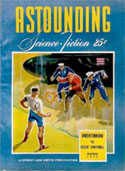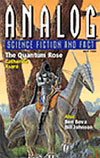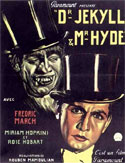Can science fiction stories predict the future? With Visions of Tomorrow: Science Fiction Predictions That Came True, editors Thomas A. Easton and Judith K. Dial gathered tales by such science fiction luminaries as H.G. Wells, Charles Sheffield, Gregory Benford and Murray Leinster that all have one thing in common … they (in some way or another) predicted the future and were (mostly) right.
Summary
The short stories in this anthology are organized into five basic groups:
- Those that predicted things that have come to pass,
- Those that predicted things that are almost here,
- Those that predicted computer technologies,
- Those that predicted biological technologies and
- Those that very well might still happen.
Organizing them this way allowed the authors to not only reveal the stories in a chronologically comprehensible fashion, but made each story, in some way build historically from the one before it.
What Worked for Me
 A few of the stories in this collection I’d read about, but had never read. Case in point was “Deadline” by Cleve Cartmill, which described the atomic bomb so accurately, the government thought there was a leak and tried to quash it. I’d heard so much about this aspect of the story, that I was taken by surprise when I actually read it. It was not what I expected it to be, which was very refreshing.
A few of the stories in this collection I’d read about, but had never read. Case in point was “Deadline” by Cleve Cartmill, which described the atomic bomb so accurately, the government thought there was a leak and tried to quash it. I’d heard so much about this aspect of the story, that I was taken by surprise when I actually read it. It was not what I expected it to be, which was very refreshing.
 The further into the book I read, the more entertaining I found the stories. Most likely because they were newer and therefore not as dated. The tales I found most enjoyable were “E-Mage” by Rajnar Vajra (Analog, July 1999) which was about identity theft, and “Misprint” by Vonda N. McIntyre (Nature, July 9, 2008), which was about 3D printing of living things.
The further into the book I read, the more entertaining I found the stories. Most likely because they were newer and therefore not as dated. The tales I found most enjoyable were “E-Mage” by Rajnar Vajra (Analog, July 1999) which was about identity theft, and “Misprint” by Vonda N. McIntyre (Nature, July 9, 2008), which was about 3D printing of living things.
What Didn’t Work for Me
It took me awhile to get through the first two stories by Edgar Allan Poe and H.G. Wells. Although I’m a fan of both writers, I found “The Balloon Hoax” by Poe and “The Land Ironclads” by Wells to be dull. This was in part to their being so dated.
 But they also suffered from what I call the “Dr. Jekyll and Mr. Hyde syndrome.” You see, the meme of having one’s light and dark sides split into two individuals is so well known that you can’t read the novel and enjoy it for how it was written. Robert Louis Stevenson wrote Strange Case of Dr. Jekyll and Mr. Hyde as a mystery, only revealing who Mr. Hyde was at the end. If you know who he is, the novella is not all that interesting.
But they also suffered from what I call the “Dr. Jekyll and Mr. Hyde syndrome.” You see, the meme of having one’s light and dark sides split into two individuals is so well known that you can’t read the novel and enjoy it for how it was written. Robert Louis Stevenson wrote Strange Case of Dr. Jekyll and Mr. Hyde as a mystery, only revealing who Mr. Hyde was at the end. If you know who he is, the novella is not all that interesting.
Conclusion
For those who enjoy the historical aspects of science fiction, who enjoy understanding the historical and sociological context in which stories were written and peering into the past of science fiction, this anthology will be a welcomed addition to your library.
Score: 3 Palm Trees out of 5 Possible
NOTE: Although I received this book free to review, that did not affect my opinion of the book. Read past reviews of books I’ve received for free and you’ll know I don’t hold my punches.

Pingback: The Genre Traveler | Novel Publicity